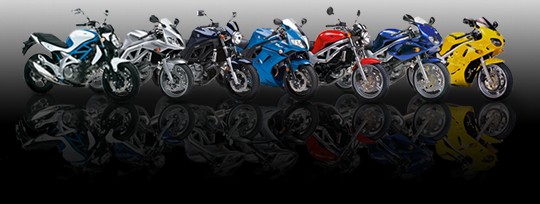 |
 |
| SV Talk, Tuning & Tweaking Discussion and chat on all topics and technical stuff related to the SV650 and SV1000 Need Help: Try Searching before posting |
 |
|
|
Thread Tools |
|
|
#1 |
|
Guest
Posts: n/a
|
Overhauled my front brake calipers at the weekend.
I’ve seen a few threads on here, so maybe re-inventing the wheel, but as I took pictures along the way, I thought I’d produce a write up which may be useful to anyone doing this for the 1st time. Bike is 2010 SV650S with 23,000 miles on the clock, ridden all year round. For this reason, I wasn’t too precious about getting every surface of the caliper looking shiny, instead I concentrated on getting the vital moving/sliding parts clean & serviceable. Any comments, useful hints & tips, better ways of doing things are always welcome to improve/simplify the process. The Materials/Tools I Used: 2 bags labelled LH & RH to keep all your bits together with each caliper. 12mm socket for the banjo bolts. 14mm socket for the caliper mounting bolts. Small pliers. Worksop Blue Roll for protecting bike from brake fluid and general wiping up. G-Clamp, kitchen foil, 4 x 10p coins (banjo isolation). Open-ended spanners or similar for piston removal spacers. 4” Paintbrush with cut down bristles. Paraffin. Shallow plastic bowl/tray general cleaning (surplus cat litter tray is perfect !). Wooden BBQ Skewer for cleaning seal grooves. Cif kitchen Cream cleaner (I bottled out of using the dishwasher !). Toothbrush. Pack of Scotchbrite Cleaning Pads. 2 x Caliper Seal kit (I used OEM). Red Rubber Grease. Copaslip. With the calipers still on the bike, I cracked the banjo bolts and nipped back up for easier removal later on. Remove caliper mounting bolts, then remove the pad retaining pin R-clip (don’t lose it) & pin. You can now remove your pads. Now you can see what winter riding does to your calipers. 1. LH Caliper.jpg2. RH Caliper.jpg Last edited by SV_archie99; 19-11-14 at 05:59 PM. |

|
|
|
#2 |
|
Guest
Posts: n/a
|
Support the calipers so they’re not hanging on the hoses.
Protect the paintwork in areas at risk from brake fluid with newspapers, blue roll or rags etc. Wrap 4 x 10p coins in kitchen foil, 2 for each caliper, and have a couple of small G-clamps ready. Edit: Good idea remove the pad spring first to ensure no chance of the piston scraping it as they come out. Start pumping the pistons out of both calipers. I used the thickness of a couple of open-ended spanners to gradually pump them out as evenly as possible. Keep an eye on the fluid level in the reservoir and keep it topped up. Repeat on both calipers, reducing the spacer thickness until you close to the point of pistons release from the bore. Once one piston pops you’ve lost you’re system pressure, so remove the banjo from that caliper – there will be spillage. G-Clamp the two foil wrapped coins to the banjo fitting to prevent further fluid loss and to re-pressurise the system for the remaining caliper. Resume pumping until the pistons release from the remaining caliper. Remove banjo and clamp the fitting with foil/coins as before. Clean up any spillage and use solvent cleaners as required. As you can see one of the dust seals has popped out with the piston. 3. Piston removal.jpg Last edited by SV_archie99; 23-11-14 at 09:42 PM. |

|
|
|
#3 |
|
Guest
Posts: n/a
|
Hopefully you should be able to wiggle the pistons free from the bores.
Resist the urge to use any pipe grips, mole-grips or similar graunchers without several layers of a suitable protective material on the pistons. I’ve heard of others using leather chamois material wrapped around the piston and then some pipe grips. I was fortunate in that I could wiggle them off by hand. Empty out any fluid residue and give each calliper a wash down with paraffin. I then bagged up each calliper and loose parts and re-located to the warmth of the dining room table. Continue with strip down of each calliper to its piece parts starting with the slider/bracket and rubber boots followed by the pad spring. Pay attention to the pad spring orientation, it has ridges, which correspond to the location of the fixed pad. 4. Pistons & Slider removed with comments.jpg Last edited by SV_archie99; 19-11-14 at 05:59 PM. |

|
|
|
#4 |
|
Guest
Posts: n/a
|
The slider/bracket has a pad guide shim, I took a couple of pictures as a reminder to its orientation.
5. Slider.jpg Here's a view of the opposite side. 6. Slider (other side).jpg |

|
|
|
#5 |
|
Guest
Posts: n/a
|
Using a wooden BBQ skewer I removed the two seals, the outer dust seal and the inner, wider piston seal.
I left my bleed nipples in place, as they looked OK. So youíre left with this collection of piece parts. 7. Piece parts for cleaning.jpg |

|
|
|
#6 |
|
Guest
Posts: n/a
|
I went to work on the piece parts with the Cif kitchen cream cleaner using my paintbrush and scotchbrite.
For the seal grooves I used a wooden BBQ skewer, which could be shaped with a knife to suit the seal grooves dimensions. A combination of scraping with the skewer, a toothbrush and more CIF got the grooves nice and clean. I have a Dremmel but the only cleaning attachment to hand was a wire brush head, as I was worried about damage to the grooves I persevered by hand. A brass or nylon brush head is on the shopping list for next time. Oddly enough the grooves in one caliper was in a much worse state than the other Ė Different build operatives at the Suzuki factory ? After cleaning, ensure all parts are thoroughly rinsed & dried. 8. Seal Grooves Cleaned Up.jpg |

|
|
|
#7 |
|
Guest
Posts: n/a
|
Next up it was time to look at the pistons. On first glance you would say, scrap...
10. Piston Corrosion.jpg But I decided with nothing to lose, I would give then a go with the scotchbrite & Cif combo to see if they could be salvaged. I cut some 1” wide strips of scotchbrite and kept rotating the piston in the scotchbrite & Cif. Some of the crud was brake dust & grime, and soon progress could be seen. Here’s a comparison shot between one that’s untouched and one that’s been given a bit of attention. 9. One Scotchbrite'd.jpg With a few pads of scotchbrite used and a few tea breaks to rest aching fingers almost all of the surface corrosion was gone and I was pretty pleased with the results. I think for future I will look to utilise a rubber bung or large diameter wooden dowel to grip the inner diameter of the piston and hook it up to a drill using a bolt. This way I can spin the piston at a slow speed while holding the scotchbrite on the outer surface. 11. Pistons Buffed up.jpg Last edited by SV_archie99; 19-11-14 at 07:50 PM. |

|
|
|
#8 |
|
Guest
Posts: n/a
|
Now time to re-assemble. Obtain the new seals and coat in a thin layer of RRG.
Install seals in the recesses. 12. New Seals & RRG.jpg Coat pistons in a thin layer of RRG and install squarely in the bores. When square they should slide home with a satisfying thud. As the pistons are pushed home the excess RRG will be collected at the exposed end of the piston, affording some future weather protection. Ensure pistons are pushed all the way to the bottom of the bore to minimise the amount of air to be expelled during later bleeding. 13. Seals installed, Pistons installation.jpg Next up was the application of RRG to the slider rubber boots and the slider bore - donít go crazy, you donít need to fill it up. Re-install the rubber boots. To get the long one in, fold it in half across itís diameter and feed it through the bore. Pull it through and wiggle it around to regain its shape. 14. Slider boots RRG'd and fitted.jpg |

|
|
|
#9 |
|
Guest
Posts: n/a
|
The pad retainer shim was given a thin coating of copaslip and installed on the slider/bracket.
The sliding pins are given a coat of RRG. 15. Slider RRG'd & Copaslip on shim.jpg I gave the pad spring a thin coating of copaslip on both sides and installed back in the calliper body. Install the slider/bracket pins into the rubber boots. Ensure the boots are correctly seated in the retaining recesses. 16. Anti Rattle shim copaslip'd and slider installed.jpg |

|
|
|
#10 |
|
Guest
Posts: n/a
|
Give the pad retaining pin a thin coat of copaslip.
Install both pads, install pad retaining pin and fit R-clip. 17. Pad retainer copalip'd & pads installed.jpg Bolt the calipers back on the fork, again a bit of copaslip on the bolts. Refit the banjos & bleed the brakes. And that's about it. I have not fitted them to the bike as yet and done the bleeding, that will be this weekends job. Hope this is is of some use to you out there. It really isn't that difficult, just take your time and be methodical, taking lots of picture during dissaembly will help. Cheers Last edited by SV_archie99; 23-11-14 at 09:39 PM. |

|
 |
|
|
 Similar Threads
Similar Threads
|
||||
| Thread | Thread Starter | Forum | Replies | Last Post |
| Caliper overhaul, where exactly to grease? | AkiraSV | SV Talk, Tuning & Tweaking | 8 | 08-10-13 10:32 PM |
| Brake caliper overhaul | muzikill | SV Talk, Tuning & Tweaking | 51 | 18-06-13 08:51 AM |
| Front brake caliper overhaul. | Danny Dickinson | SV Talk, Tuning & Tweaking | 24 | 31-08-12 11:16 AM |
| Caliper overhaul. | arcdef | SV Talk, Tuning & Tweaking | 114 | 31-01-09 04:57 PM |
| Caliper Overhaul Kit | Cam_73 | SV Talk, Tuning & Tweaking | 6 | 16-06-08 02:32 PM |